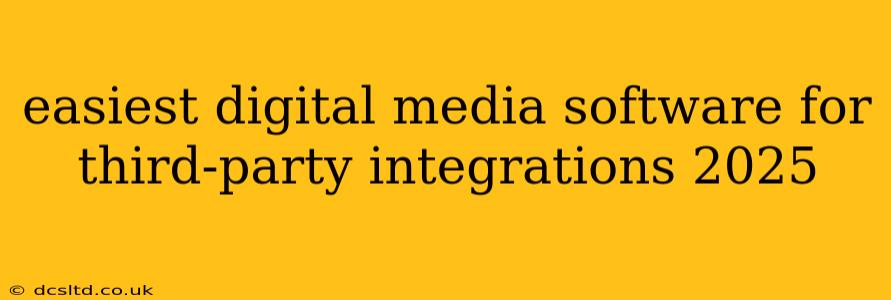The digital media landscape is constantly evolving, with new software and integration possibilities emerging regularly. Choosing the right software for your needs depends heavily on your workflow and specific integrations. However, focusing on ease of third-party integration is crucial for streamlining workflows and maximizing efficiency. This article explores some of the easiest digital media software options for third-party integrations in 2025, considering factors like user-friendliness, API accessibility, and the breadth of available integrations.
While predicting the future definitively is impossible, we can analyze current trends and leading software to project which will likely remain user-friendly and integration-rich in 2025. The "easiest" software is subjective, depending on the user's technical expertise, but we'll focus on platforms known for their intuitive interfaces and robust integration capabilities.
What to Consider When Choosing Digital Media Software
Before diving into specific software, let's address key considerations influencing the "easiest" choice for third-party integrations:
- API Accessibility and Documentation: A well-documented and accessible API is crucial for seamless integration. Look for software with clear API documentation and readily available developer support.
- Integration Marketplace/Directory: A built-in marketplace or directory simplifies finding and connecting with third-party tools. This drastically reduces the technical hurdles.
- Pre-built Connectors: Software with pre-built connectors for popular tools (like marketing automation platforms, CRM systems, or analytics dashboards) minimizes the setup time and technical expertise required.
- User Interface (UI): An intuitive and user-friendly UI is crucial, even with robust integrations. Complex software can negate the benefits of easy integration if it's difficult to navigate.
Leading Contenders for Easiest Third-Party Integrations (2025 Projection)
While specific rankings can change rapidly, several platforms are likely to maintain their position as leaders in ease of third-party integration in 2025:
1. Adobe Creative Cloud: Adobe's extensive ecosystem boasts robust integration between its various applications (Photoshop, Illustrator, Premiere Pro, etc.) and third-party tools. While individual apps might have their nuances, the overall platform's integration capabilities are strong, and Adobe consistently updates its APIs and integration options.
2. Figma: This collaborative design tool has gained immense popularity, partly due to its extensive API and integrations. Figma’s plugin ecosystem allows for a vast array of extensions and connections to other tools, making it a strong contender for ease of integration.
3. Zapier/IFTTT: While not digital media software themselves, these automation platforms excel at connecting various applications, including many digital media tools. They function as bridges, simplifying integrations between software that might not otherwise have direct connections. Their no-code interfaces are a significant plus for users lacking coding skills.
4. Cloud-Based Video Editing Platforms (e.g., DaVinci Resolve Cloud): Cloud-based solutions are increasingly emphasizing seamless integration with other cloud services and applications, streamlining workflows and promoting collaboration. Look for platforms that explicitly highlight their third-party integration features.
Frequently Asked Questions (Based on Common Search Queries)
What are some examples of third-party integrations for digital media software?
Third-party integrations for digital media software can range widely. Examples include:
- Marketing Automation: Connecting your video editing software to a marketing automation platform to automatically schedule social media posts of finished videos.
- CRM Integration: Linking your project management software to a CRM to track client communication and project progress.
- Storage and Collaboration Tools: Integrating with cloud storage platforms (Dropbox, Google Drive, etc.) or collaboration tools (Slack, Microsoft Teams) for easy file sharing and team communication.
- Analytics Dashboards: Connecting your video publishing platform to analytics dashboards to monitor viewership metrics.
Which software offers the most seamless workflow for third-party integrations?
The "most seamless" workflow depends on your specific needs. However, software with well-documented APIs, pre-built connectors, and user-friendly interfaces generally offers the best experience. Platforms like Adobe Creative Cloud, Figma, and those leveraging Zapier/IFTTT often provide remarkably streamlined workflows.
How do I choose the right digital media software based on integration needs?
Start by listing your essential integrations. Then, research software platforms that offer those integrations. Look for reviews and user testimonials highlighting the ease of use and reliability of those integrations. Many software providers offer free trials or demos, allowing you to test the integration process before committing.
Are there any open-source digital media tools with good third-party integration capabilities?
While fewer open-source options match the breadth of integrations offered by commercial solutions, some do offer robust APIs and community-supported plugins. However, the ease of integration might require more technical expertise than commercial equivalents. Researching open-source projects specifically focused on your needs is recommended.
Conclusion: Staying Ahead of the Curve
The landscape of digital media software is dynamic. The “easiest” software for third-party integrations in 2025 will likely be those that prioritize user experience, API accessibility, and a robust ecosystem of pre-built connectors and readily available developer support. Staying informed about emerging trends and new integration possibilities is crucial for maximizing productivity and efficiency. Remember to focus on your specific requirements and test different options to determine the best fit for your workflow.
